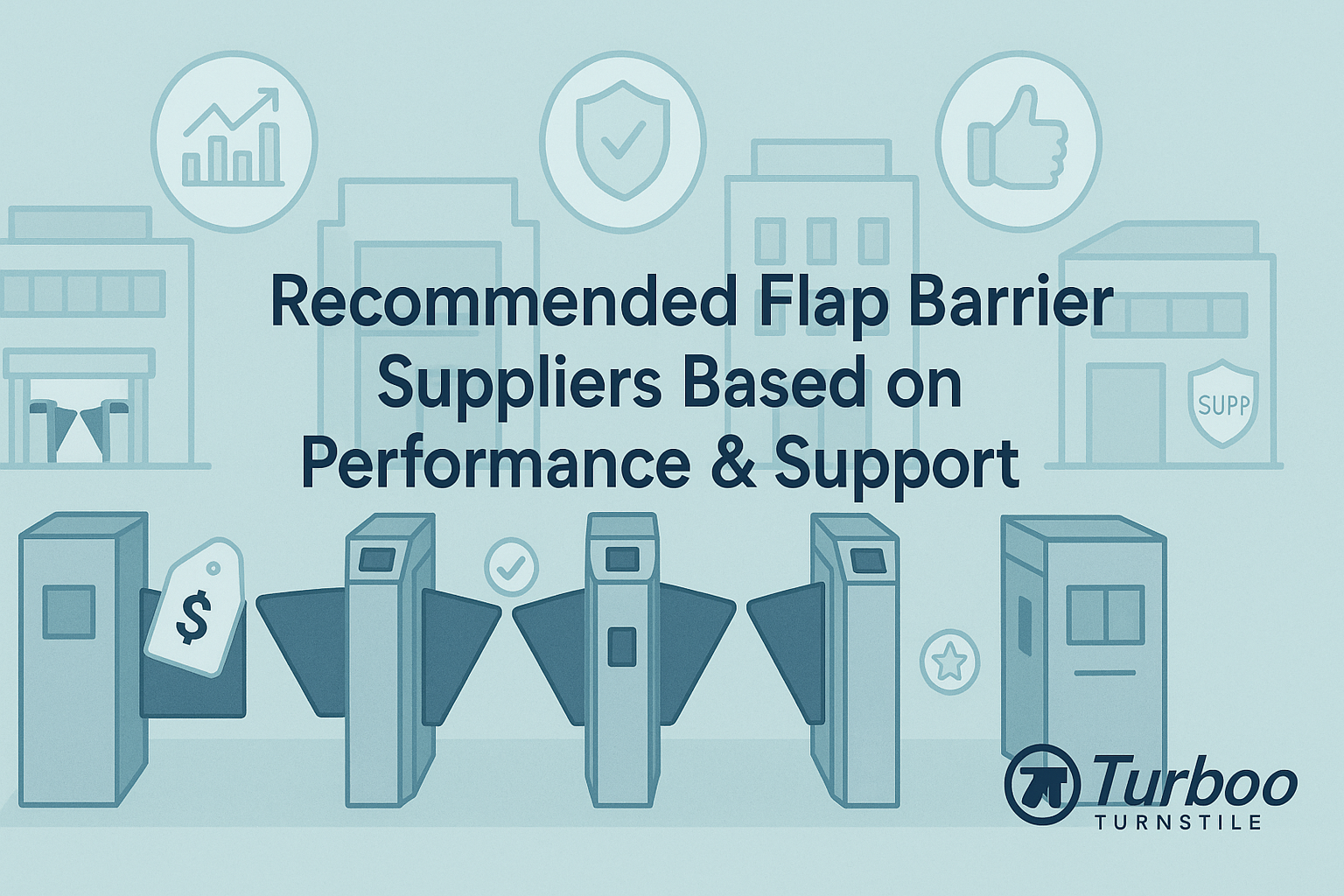Evaluating Flap Barrier Performance in Real-World Conditions


Flap barriers are often the go-to solution for securing access points in high-traffic areas, providing a seamless experience while ensuring safety. However, while these systems are designed to perform well in laboratory conditions, the true test of their effectiveness lies in how they hold up in real-world scenarios. Challenges like fluctuating traffic volumes, environmental conditions, and unexpected malfunctions make flap barrier performance a dynamic and ongoing concern. In this article, we’ll walk you through the crucial aspects of a flap barrier performance review, emphasizing the importance of evaluating them after installation to ensure long-term reliability and user satisfaction. By exploring the key metrics, testing methods, and typical challenges these systems face in day-to-day operations, you’ll learn how to make informed decisions about your barrier systems’ maintenance, upgrades, and overall effectiveness.
What Is Flap Barrier Performance Metrics
When evaluating flap barrier performance, it’s essential to have a clear understanding of the metrics that matter most. These metrics help quantify how well the system is functioning and identify areas that may need attention. Key performance indicators (KPIs) include speed, reliability, safety sensor accuracy, and user throughput.
Flap Barrier Speed
Speed is one of the most critical aspects of a flap barrier’s performance. The system must be fast enough to allow efficient movement but not too quick that it compromises user safety. Monitoring how quickly the flaps open and close under varying conditions, such as heavy foot traffic or peak hours, will provide valuable insights. In high-traffic environments like office buildings or transport hubs, slow response times can lead to congestion, frustrating users and potentially affecting security protocols.
Reliability
Reliability refers to how consistently the flap barrier operates over time. A system that frequently malfunctions, even in mild conditions, can create bottlenecks and security breaches. Monitoring the frequency of breakdowns or operational errors, such as flaps failing to open or close, is essential. A reliable barrier should function correctly day in and day out, without requiring frequent repairs or resets.
Safety Sensor Accuracy
The accuracy of safety sensors integrated into flap barriers is another key metric. These sensors detect objects in the path of the flap and prevent it from closing to avoid injury or damage. In real-world conditions, these sensors may face issues like false positives (e.g., detecting a non-existent object) or false negatives (failing to detect an obstruction). Ensuring that the safety sensors are calibrated and functioning accurately is critical for both security and user safety.
User Throughput
User throughput refers to the number of users the flap barrier can efficiently accommodate in a given time frame. A high throughput is particularly important in facilities that experience significant foot traffic, such as airports, stadiums, or commercial offices. Monitoring how well the system can handle large volumes of users without delays or interruptions is a key component of any flap barrier performance review. Performance testing during peak hours is an effective way to assess this metric.
Typical Real-World Challenges
Even the best-designed flap barriers can face issues when deployed in the field. Various factors, ranging from environmental conditions to user behavior, can influence how well these systems perform. Identifying and understanding these challenges is crucial for any flap barrier evaluation.
Traffic Volume
One of the most common challenges faced by flap barriers is handling fluctuating traffic volumes. During busy periods, such as rush hours or special events, the barrier might be required to handle a higher number of users than during normal operations. This can lead to delays if the system is not designed to accommodate such surges. A flap barrier that works fine during light traffic may struggle to maintain performance in these peak conditions.
Environmental Conditions
Weather and environmental conditions can have a significant impact on flap barrier performance. In outdoor installations, exposure to rain, snow, extreme heat, or cold can affect the barrier’s mechanical components, sensors, and power systems. For instance, moisture might cause rust or corrosion in metal parts, while extreme temperatures can cause certain materials to become brittle or warp. Flap barrier systems in such conditions must be built with durability in mind, and regular checks should be conducted to ensure that environmental factors do not hinder performance.
Vandalism and Accidental Damage
Flap barriers installed in high-security environments or public spaces are often vulnerable to vandalism and accidental damage. This may involve deliberate tampering with the barrier mechanism or unintentional impacts from users or objects. While the barriers are typically designed to withstand some degree of force, recurring damage can lead to performance degradation over time. For instance, a damaged flap might not open or close properly, or it might become misaligned, affecting user throughput and safety.
Power Issues
Flap barriers rely on a steady power supply to operate. Inconsistent power, such as power surges or outages, can disrupt operations and even damage the system. Backup power systems, such as uninterruptible power supplies (UPS), are crucial for ensuring that barriers continue to function during power interruptions. Monitoring the power supply and conducting regular checks on backup systems is an essential part of a comprehensive flap barrier performance review.
Testing Methods for Flap Barrier Evaluation
To thoroughly evaluate flap barrier performance, specific testing methods must be employed. These methods provide objective data about the system’s functionality and help identify weaknesses that may not be immediately obvious during casual observation.
Real-Time Testing
Real-time testing involves observing the barrier in operation during regular use. By tracking various metrics such as speed, reliability, and throughput during actual operation, you can gain valuable insights into how the barrier behaves under normal conditions. Real-time testing also allows you to assess how the system performs during peak hours, offering a more accurate picture of its capabilities.
Environmental Stress Testing
Environmental stress testing simulates extreme conditions to evaluate how well the barrier can handle environmental challenges such as weather, temperature extremes, or heavy vandalism. By subjecting the barrier to these conditions in a controlled setting, you can determine whether the system is adequately prepared for real-world challenges. This form of testing helps identify potential weak points in the system’s design or materials.
User Experience Evaluation
User experience (UX) evaluation focuses on how easy and efficient it is for users to interact with the flap barrier. This evaluation involves tracking user behaviors, identifying any user confusion or frustration, and measuring overall satisfaction with the system. For example, if users frequently tap the barrier or seem unsure of how to use it, this might indicate issues with the barrier’s design or interface. Gathering feedback directly from users during their interaction with the system is an important aspect of a real-world flap barrier evaluation.
Safety Testing
Safety testing is critical to ensure that the flap barrier’s sensors are functioning as intended. This includes verifying that the sensors correctly detect obstructions and prevent the flaps from closing when necessary. In some cases, sensors may require recalibration to ensure accuracy. Testing should be conducted both in ideal conditions and during high-traffic times when sensor accuracy may be more prone to issues.
Interpreting Results for Maintenance and Upgrades
Once testing is complete, interpreting the results is crucial for determining next steps regarding maintenance, repairs, or upgrades. By analyzing the data from the performance review, you can prioritize issues and decide whether the barrier requires minor adjustments or major overhauls.
Data Analysis
The first step in interpreting flap barrier performance review data is to analyze the results from different metrics, such as speed, throughput, reliability, and sensor accuracy. Look for patterns that indicate any weaknesses. For example, if you notice a consistent slowdown in the barrier’s speed during peak traffic hours, it may be a sign that the system’s motor needs to be upgraded or calibrated. Similarly, if safety sensors are regularly triggered by false positives, recalibration or replacement may be necessary.
Data analysis also includes reviewing logs of operational errors or breakdowns. Frequent malfunctions in a particular component may suggest that the part is defective or reaching the end of its life cycle. Identifying these issues early can help you avoid costly repairs down the road.
Maintenance Scheduling
A key outcome of flap barrier performance reviews is the establishment of a maintenance schedule. Regular inspections and timely repairs are essential for keeping the barrier in optimal condition. Based on the data collected during testing, you can create a schedule for routine checks on the system’s components, such as sensors, motors, and power supply. Preventative maintenance, based on performance review data, helps reduce the risk of unexpected breakdowns and extends the lifespan of the system.
In addition, using performance metrics like user throughput and reliability to schedule maintenance ensures that barriers can be serviced during off-peak hours, minimizing disruptions to users. Maintenance should also be aligned with the environmental conditions—barriers exposed to harsh weather may require more frequent checks than those in controlled environments.
Deciding on Upgrades
If your performance review indicates that a flap barrier is consistently underperforming or struggling with specific challenges, it may be time to consider upgrades. For example, if heavy traffic and throughput demands exceed the system’s capabilities, upgrading to a higher-capacity model could resolve these issues. Alternatively, if weather-related damage is a common problem, you may need to replace the system’s outer casing or invest in a barrier that is more resistant to environmental factors.
Upgrades could also include improving sensor accuracy with more advanced technologies, adding redundant power systems, or even installing software updates that enhance the barrier’s functionality. Review the costs and benefits of such upgrades to determine if they align with your facility’s long-term needs.
The Importance of Ongoing Flap Barrier Performance Reviews
Flap barriers are not “set it and forget it” systems. While an initial installation may seem perfect, the reality is that their performance will inevitably change over time due to factors like wear and tear, environmental exposure, and evolving security requirements. Regular flap barrier performance reviews are essential to ensure that the system continues to meet both security and operational goals.
Adapting to Changing Conditions
Ongoing performance reviews allow facility managers and security leads to stay ahead of changing conditions. For instance, if your facility experiences changes in foot traffic or a shift in user behavior, a review can reveal if your current flap barrier setup is still optimal. Additionally, as environmental factors change over time (e.g., seasonal weather variations), regular reviews can determine if adjustments or repairs are needed.
Aligning with Security Protocols
Security requirements evolve as new threats emerge. What may have been a sufficient level of security during the system’s initial installation might no longer be adequate. Through regular performance reviews, you can assess whether the flap barrier is still aligned with your current security protocols. This may involve adjusting the system’s access controls, modifying sensor configurations, or implementing software updates to address evolving security challenges.
Ensuring Compliance and Safety
Ongoing performance assessments are also essential for ensuring compliance with local regulations and safety standards. These regulations may change over time, and a performance review ensures that your flap barrier system continues to meet these requirements. In many industries, it’s not just about keeping barriers operational—it’s also about guaranteeing they’re up to code.
Conclusion
Evaluating flap barrier performance in real-world conditions is essential for ensuring security, efficiency, and longevity. By regularly reviewing performance metrics like speed, reliability, sensor accuracy, and user throughput, facility managers can proactively identify issues and make informed decisions about maintenance, repairs, or upgrades. Real-world testing, environmental assessments, and ongoing monitoring contribute significantly to the overall success of flap barrier systems, ensuring that they continue to meet the needs of your facility. With the insights gained from thorough evaluations, you can optimize barrier functionality, enhance user satisfaction, and minimize downtime, ultimately improving the security and operations of your facility.
Frequently Asked Questions (FAQs)
- Why is flap barrier speed so important?
Speed directly impacts user experience and throughput. If a flap barrier is too slow, it can cause delays, especially during high-traffic times, resulting in frustration and potential security concerns. - What environmental factors affect flap barrier performance?
Weather conditions like extreme temperatures, rain, snow, and even high humidity can degrade barrier components, affecting motor function, sensors, and overall durability. - How often should I conduct a flap barrier performance review?
It’s recommended to conduct a performance review at least twice a year, or more frequently if the barrier experiences high traffic volumes or harsh environmental conditions. - Can flap barriers withstand vandalism?
Flap barriers are designed to be robust, but frequent vandalism or heavy impacts can cause damage. Regular maintenance and immediate repairs are necessary to keep the system functioning. - What should I do if my flap barrier is malfunctioning?
Identify the cause of the malfunction—whether it’s sensor failure, mechanical issues, or power supply disruptions. Based on the performance review, you may need to recalibrate the system, replace parts, or upgrade components.












